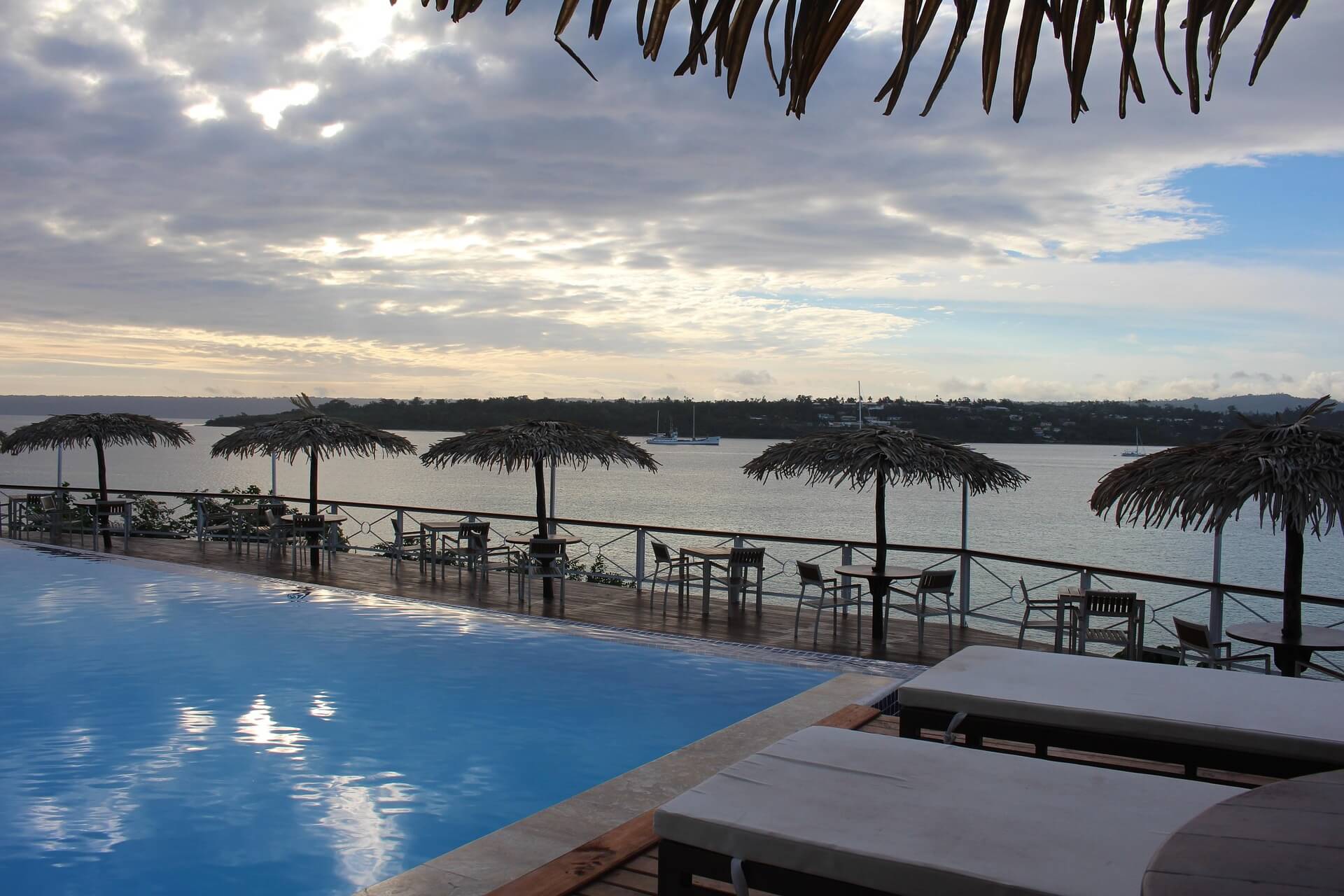Travel in Vanuatu

Adventure, culture, and volcanoes in the wild heart of the Pacific
Vanuatu is the South Pacific’s ultimate blend of raw nature and living tradition. Made up of over 80 islands stretching across volcanic ridges and coral reefs, this island nation offers the kind of off-the-beaten-track experience that leaves a deep and lasting impression. One day, you’re hiking to the rim of an erupting volcano. The next, you’re welcomed into a thatched-roof village where kastom dances and kava ceremonies have been passed down for centuries.
Whether you seek adventure, cultural immersion, diving, or pure escape, Vanuatu delivers — not with luxury or polish, but with authenticity and intensity. From the black sand beaches of Ambrym to the blue holes of Espiritu Santo, this is one of the South Pacific’s most rewarding and multi-layered destinations.
How to Get to Vanuatu
International flights arrive at Bauerfield International Airport (VLI) in Port Vila, on the island of Efate.
- Direct flights operate from Australia (Brisbane, Sydney), New Zealand (Auckland), Fiji, New Caledonia, and occasionally Solomon Islands.
- Air Vanuatu is the national carrier and operates both international and domestic routes.
- Domestic connections link Port Vila with other major islands including Espiritu Santo (Luganville), Tanna, Pentecost, Ambrym, and Malekula.
While inter-island flights are the fastest way to travel, ferries and cargo boats also serve the more remote islands and offer a slower, scenic way to experience the archipelago.
What to See in Vanuatu
Start in Port Vila, the capital and cultural gateway. Set along a horseshoe-shaped bay, the town is vibrant yet relaxed, with bustling markets, colonial architecture, and waterfront restaurants. Visit the National Museum of Vanuatu to learn about Melanesian heritage and the complex belief systems that still shape daily life.
Just outside the city, the island of Efate offers waterfalls, oceanfront resorts, and cultural villages where you can learn about local customs, from sand drawing to traditional medicine. The Ekasup Cultural Village is one of the best introductions to Vanuatu’s kastom (custom law) way of life.
To the north lies Espiritu Santo, home to the famous blue holes — deep, freshwater springs in the jungle, perfect for swimming and kayaking. Santo also features Champagne Beach, one of the South Pacific’s most pristine stretches of sand, and Million Dollar Point, where WWII equipment was dumped into the sea — now a popular dive site alongside the wreck of the SS President Coolidge.
But perhaps the most unforgettable sight in Vanuatu is on Tanna Island: Mount Yasur, one of the most accessible active volcanoes on Earth. You can hike to its rim and watch red-hot lava spurt into the sky — a primal experience that captures Vanuatu’s wild edge.
What to Do in Vanuatu
Vanuatu is built for soft adventure and cultural connection.
Climb volcanoes, swim in jungle springs, dive coral reefs and war wrecks, or explore the coast by kayak. The diving is especially good on Santo and Efate, with sites suitable for beginners and advanced divers alike. Snorkelers can explore vibrant reefs just meters from shore.
On land, take part in tribal ceremonies, walk through ancient banyan forests, and taste traditional dishes like lap lap and fresh-caught reef fish. Join a kava ceremony, where the mildly sedating root drink is consumed communally and often in silence. These experiences are not tourist shows — they are part of daily life, shared with sincerity.
Vanuatu is also one of the only places on Earth where you can witness the land diving ritual of Pentecost (April–June). Predecessor to modern bungee jumping, this sacred ceremony involves men leaping from tall wooden towers with vines tied to their ankles — a rite of passage that blends spiritual belief, bravery, and breathtaking spectacle.
When to Visit Vanuatu
Vanuatu enjoys a warm tropical climate year-round, averaging 24–30°C (75–86°F).
- Best time to visit: May to October (dry season), with cooler temperatures, low humidity, and ideal conditions for travel and adventure.
- Wet season: November to April — brings lush landscapes, occasional tropical storms, and higher humidity.
Many cultural festivals and land diving ceremonies occur in the dry season, making it a rewarding time to experience both nature and tradition.
Travel Tips for Vanuatu
- Currency: Vanuatu Vatu (VUV)
- Language: Bislama (national language), English and French (official), plus over 100 local languages spoken regionally.
- Transport: Domestic flights are efficient; taxis and minivans serve towns like Port Vila and Luganville.
- Health: Tap water is not always safe to drink — bring purification tablets or buy bottled water. Malaria is present in some islands — check recommendations in advance.
Vanuatu is where the earth speaks loudly, the sea remains generous, and culture is alive in every village, drumbeat, and handshake. It’s a place where you hike through ash fields, bathe in turquoise springs, listen to origin stories under banyan trees, and stand in awe beneath the stars with a volcano rumbling in the distance.
It may not be the easiest place to reach, or the most convenient — but for those who come, Vanuatu is unforgettable. It offers the kind of deep travel experience that stays with you long after the sand is gone from your shoes.